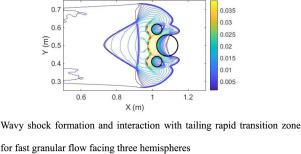当前位置:
X-MOL 学术
›
J. Fluids Struct.
›
论文详情
Our official English website, www.x-mol.net, welcomes your
feedback! (Note: you will need to create a separate account there.)
Numerical simulation of fast granular flow facing obstacles on steep terrains
Journal of Fluids and Structures ( IF 3.4 ) Pub Date : 2020-11-01 , DOI: 10.1016/j.jfluidstructs.2020.103162 Su Yang , Xiaoliang Wang , Qingquan Liu , Menghan Pan
Journal of Fluids and Structures ( IF 3.4 ) Pub Date : 2020-11-01 , DOI: 10.1016/j.jfluidstructs.2020.103162 Su Yang , Xiaoliang Wang , Qingquan Liu , Menghan Pan

|
Abstract The interaction between fast shallow granular flow and obstacles on steep terrain is an important aspect of granular mechanics and defending against geological hazards. In this study, we used a depth-averaged model for granular flow facing obstacles on steep terrains in a bed-fitted coordinate system where the obstacle system is treated as a local bed deviation term. A second-order Riemann-free scheme is extended to compute the depth-averaged model with a wetting–drying technique, which is verified by several granular flow cases, such as aluminum bar collapse and granular flow runout on a steep slope. Numerical simulations were performed for the case of granular flow facing a (i) single hemispherical obstacle and (ii) system of three hemispherical obstacles to produce a dynamical process and deposit profile, and show good agreement with experimental results. Granular flow facing a single obstacle on a concave plane produces a detached shock wave that moves upstream and a tailing rapid transition zone that moves down, which will merge to form a new shock for deposition. Granular flows facing a three-hemisphere obstacle system produce a tailing rapid transition zone that moves downstream and a downstream wavy shock that results from the interaction of three bow shocks in front of each obstacle. The downstream wavy shock moves upstream and merges with the upstream transition zone to form a new curved shock, which later relaxes to a deposit owing to bed friction. These findings provide some supplemental understandings of flow structures of fast granular flow facing obstacles.
中文翻译:

陡峭地形上快速颗粒流面对障碍物的数值模拟
摘要 快速浅层颗粒流与陡峭地形障碍物的相互作用是颗粒力学和防御地质灾害的一个重要方面。在这项研究中,我们使用深度平均模型来处理陡峭地形上面向障碍物的颗粒流,该模型在适合床的坐标系中,其中障碍系统被视为局部床偏差项。扩展了二阶无黎曼方案以使用干湿技术计算深度平均模型,该模型已通过几种颗粒流情况进行验证,例如铝棒坍塌和陡坡上的颗粒流跳动。对颗粒流面临 (i) 单个半球障碍物和 (ii) 三个半球障碍物系统的情况进行了数值模拟,以产生动态过程和沉积物剖面,并与实验结果吻合良好。颗粒流在凹面上面对单个障碍物,会产生一个向上移动的分离激波和一个向下移动的拖尾快速过渡带,它们将合并形成新的沉积激波。面对三半球障碍系统的颗粒流会产生一个向下游移动的尾随快速过渡区和一个下游波浪形激波,这是由于每个障碍物前面的三个弓形激波相互作用而产生的。下游波浪状激波向上游移动并与上游过渡带合并形成新的弯曲激波,随后由于床层摩擦而松弛成沉积物。这些发现为快速颗粒流面临障碍的流动结构提供了一些补充理解。颗粒流在凹面上面对单个障碍物,会产生一个向上移动的分离激波和一个向下移动的拖尾快速过渡带,它们将合并形成新的沉积激波。面对三半球障碍系统的颗粒流会产生一个向下游移动的尾随快速过渡区和一个下游波浪形激波,这是由于每个障碍物前面的三个弓形激波相互作用而产生的。下游波浪状激波向上游移动并与上游过渡带合并形成新的弯曲激波,随后由于床层摩擦而松弛成沉积物。这些发现为快速颗粒流面临障碍的流动结构提供了一些补充理解。颗粒流在凹面上面对单个障碍物,会产生一个向上移动的分离激波和一个向下移动的拖尾快速过渡带,它们将合并形成新的沉积激波。面对三半球障碍系统的颗粒流会产生一个向下游移动的尾随快速过渡区和一个下游波浪形激波,这是由于每个障碍物前面的三个弓形激波相互作用而产生的。下游波浪状激波向上游移动并与上游过渡带合并形成新的弯曲激波,随后由于床层摩擦而松弛成沉积物。这些发现为快速颗粒流面临障碍的流动结构提供了一些补充理解。将合并形成新的沉积冲击波。面对三半球障碍系统的颗粒流会产生一个向下游移动的尾随快速过渡区和一个下游波浪形激波,这是由于每个障碍物前面的三个弓形激波相互作用而产生的。下游波浪状激波向上游移动并与上游过渡带合并形成新的弯曲激波,随后由于床层摩擦而松弛成沉积物。这些发现为快速颗粒流面临障碍的流动结构提供了一些补充理解。将合并形成新的沉积冲击波。面对三半球障碍系统的颗粒流会产生一个向下游移动的尾随快速过渡区和一个下游波浪形激波,这是由于每个障碍物前面的三个弓形激波相互作用而产生的。下游波浪状激波向上游移动并与上游过渡带合并形成新的弯曲激波,随后由于床层摩擦而松弛成沉积物。这些发现为快速颗粒流面临障碍的流动结构提供了一些补充理解。下游波浪状激波向上游移动并与上游过渡带合并形成新的弯曲激波,随后由于床层摩擦而松弛成沉积物。这些发现为快速颗粒流面临障碍的流动结构提供了一些补充理解。下游波浪状激波向上游移动并与上游过渡带合并形成新的弯曲激波,随后由于床层摩擦而松弛成沉积物。这些发现为快速颗粒流面临障碍的流动结构提供了一些补充理解。
更新日期:2020-11-01
中文翻译:

陡峭地形上快速颗粒流面对障碍物的数值模拟
摘要 快速浅层颗粒流与陡峭地形障碍物的相互作用是颗粒力学和防御地质灾害的一个重要方面。在这项研究中,我们使用深度平均模型来处理陡峭地形上面向障碍物的颗粒流,该模型在适合床的坐标系中,其中障碍系统被视为局部床偏差项。扩展了二阶无黎曼方案以使用干湿技术计算深度平均模型,该模型已通过几种颗粒流情况进行验证,例如铝棒坍塌和陡坡上的颗粒流跳动。对颗粒流面临 (i) 单个半球障碍物和 (ii) 三个半球障碍物系统的情况进行了数值模拟,以产生动态过程和沉积物剖面,并与实验结果吻合良好。颗粒流在凹面上面对单个障碍物,会产生一个向上移动的分离激波和一个向下移动的拖尾快速过渡带,它们将合并形成新的沉积激波。面对三半球障碍系统的颗粒流会产生一个向下游移动的尾随快速过渡区和一个下游波浪形激波,这是由于每个障碍物前面的三个弓形激波相互作用而产生的。下游波浪状激波向上游移动并与上游过渡带合并形成新的弯曲激波,随后由于床层摩擦而松弛成沉积物。这些发现为快速颗粒流面临障碍的流动结构提供了一些补充理解。颗粒流在凹面上面对单个障碍物,会产生一个向上移动的分离激波和一个向下移动的拖尾快速过渡带,它们将合并形成新的沉积激波。面对三半球障碍系统的颗粒流会产生一个向下游移动的尾随快速过渡区和一个下游波浪形激波,这是由于每个障碍物前面的三个弓形激波相互作用而产生的。下游波浪状激波向上游移动并与上游过渡带合并形成新的弯曲激波,随后由于床层摩擦而松弛成沉积物。这些发现为快速颗粒流面临障碍的流动结构提供了一些补充理解。颗粒流在凹面上面对单个障碍物,会产生一个向上移动的分离激波和一个向下移动的拖尾快速过渡带,它们将合并形成新的沉积激波。面对三半球障碍系统的颗粒流会产生一个向下游移动的尾随快速过渡区和一个下游波浪形激波,这是由于每个障碍物前面的三个弓形激波相互作用而产生的。下游波浪状激波向上游移动并与上游过渡带合并形成新的弯曲激波,随后由于床层摩擦而松弛成沉积物。这些发现为快速颗粒流面临障碍的流动结构提供了一些补充理解。将合并形成新的沉积冲击波。面对三半球障碍系统的颗粒流会产生一个向下游移动的尾随快速过渡区和一个下游波浪形激波,这是由于每个障碍物前面的三个弓形激波相互作用而产生的。下游波浪状激波向上游移动并与上游过渡带合并形成新的弯曲激波,随后由于床层摩擦而松弛成沉积物。这些发现为快速颗粒流面临障碍的流动结构提供了一些补充理解。将合并形成新的沉积冲击波。面对三半球障碍系统的颗粒流会产生一个向下游移动的尾随快速过渡区和一个下游波浪形激波,这是由于每个障碍物前面的三个弓形激波相互作用而产生的。下游波浪状激波向上游移动并与上游过渡带合并形成新的弯曲激波,随后由于床层摩擦而松弛成沉积物。这些发现为快速颗粒流面临障碍的流动结构提供了一些补充理解。下游波浪状激波向上游移动并与上游过渡带合并形成新的弯曲激波,随后由于床层摩擦而松弛成沉积物。这些发现为快速颗粒流面临障碍的流动结构提供了一些补充理解。下游波浪状激波向上游移动并与上游过渡带合并形成新的弯曲激波,随后由于床层摩擦而松弛成沉积物。这些发现为快速颗粒流面临障碍的流动结构提供了一些补充理解。











































 京公网安备 11010802027423号
京公网安备 11010802027423号